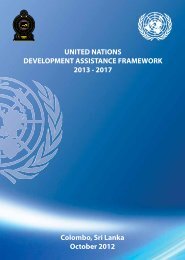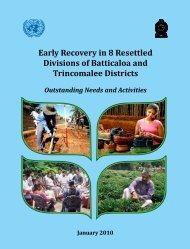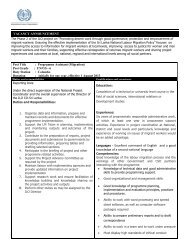Sri Lanka Human Development Report 2012.pdf
Sri Lanka Human Development Report 2012.pdf
Sri Lanka Human Development Report 2012.pdf
You also want an ePaper? Increase the reach of your titles
YUMPU automatically turns print PDFs into web optimized ePapers that Google loves.
CHAPTER<br />
3<br />
Bridging <strong>Human</strong> <strong>Development</strong> Gaps: Health<br />
Health for <strong>Human</strong> <strong>Development</strong><br />
Health is one of the fundamental rights of every human<br />
being, regardless of race, religion, political belief, or<br />
economic or social condition. 52 Physical, emotional and<br />
mental health also plays a crucial role in making people<br />
productive members of society. The Commission on<br />
Macroeconomics and Health 53 identifies it as a central<br />
factor in economic development and poverty reduction, 54<br />
while the World Health Organization notes that “health<br />
is the basis for job productivity, the capacity to learn in<br />
school, and improves the capability of individuals to grow<br />
intellectually, physically, and emotionally.” 55 The centrality<br />
of health to human development is reflected in its inclusion<br />
in the <strong>Human</strong> <strong>Development</strong> Index. 56<br />
improve. Malaysia, the Republic of Korea and Singapore<br />
all have better basic health indicators than <strong>Sri</strong> <strong>Lanka</strong>.<br />
<strong>Sri</strong> <strong>Lanka</strong>n women seem to be healthier than men in terms<br />
of life expectancy at birth. Until 1968, life expectancy for<br />
males was higher, but this advantage has been reversed in<br />
recent years. According to the latest available data, for 2000-<br />
2002, life expectancy at birth is 8.4 years longer for women<br />
than men. 57 The reasons are not clear. Several factors could<br />
be involved, including lower maternal mortality rates, the<br />
higher prevalence of non-communicable diseases among<br />
men, and improved nutrition and education.<br />
Table 3.1: Comparison of Selected Health Indicators<br />
Country life expectancy Infant mortality Under-five Maternal<br />
at birth, 2009 rate,* 2009 mortality rate,** mortality rate,***<br />
Singapore 82 2 3 9<br />
Malaysia 73 6 6 31<br />
Republic of Korea 80 5 5 18<br />
China 74 17 19 38<br />
Thailand 70 12 13 48<br />
Philippines 70 26 33 94<br />
Indonesia 68 30 39 240<br />
Maldives 75 11 13 37<br />
India 65 50 66 230<br />
Pakistan 63 70 87 260<br />
Bangladesh 65 41 52 340<br />
Nepal 67 39 48 380<br />
Myanmar 64 54 71 240<br />
<strong>Sri</strong> <strong>Lanka</strong> 71 13 16 39<br />
Notes: *:probability of dying by age one per 1,000 live births.<br />
**:probability of dying by age five per 1,000 live births.<br />
**:per 100,000 live births.<br />
Source: World Health Organization 2011.<br />
<strong>Sri</strong> <strong>Lanka</strong>’s national performance in health is good<br />
according to most basic indicators, such as life expectancy<br />
at birth, and maternity and infant mortality rates (Table<br />
3.1). Compared to more advanced economies in the Asia-<br />
Pacific region, however, <strong>Sri</strong> <strong>Lanka</strong>’s performance can still<br />
While overall progess in health has been strong, there<br />
are still concerns, both longstanding and emerging. The<br />
analysis of multidimensional poverty in Chapter 2 (and<br />
also in the Technical Note at the end of this report) shows<br />
that malnutrition, child mortality, and chronic illnesses/<br />
sri lanka <strong>Human</strong> <strong>Development</strong> report 2012 37






